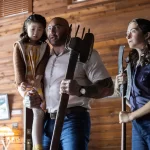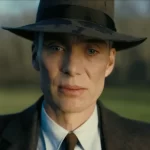Rohmerathon: Early Short Adaptations, by Scott Nye
We’re going to travel slightly back in time for the next couple legs of the Rohmerathon; I hadn’t intended on covering his shorts (aside from the early entries in the Six Moral Tales), but, as they are included in the Potemkine box set that is guiding this series, and as they are not often written about, I decided to toss them in. We’ll start with a pair of films that are not only radically different from what we typically think of as a Rohmer film, but also feature, as far as I can tell, the only lead roles he ever performed.
Based on an 1889 novella by Leo Tolstoy, Rohmer makes some interesting decisions in bringing The Kreutzer Sonata into 1956 France. The film begins with a man (Rohmer) having just killed his wife (Françoise Martinelli), before diving into a nightmarish flashback chronicling the beginning of their romance and gradual decline of their marriage into jealousy, contempt, and pettiness. Instead of a violinist, as in the Tolstoy, the man’s wife has an affair with a film critic (Jean-Claude Brialy, later the star of Rohmer’s Claire’s Knee), giving Rohmer license to capture the spirited atmosphere in the offices of Cahiers du cinéma, where he worked throughout the 1950s and into the 60s. Look for cameos by Jean-Luc Godard (who also produced this film), François Truffaut, and Andre Bazin.
The Kreutzer Sonata has a more firm emphasis on style than Rohmer’s later work, employing quick cutting, high-contrast lighting, and wandering handheld camerawork. Shot silently with a narration track and music added later, the film feels like a memory, half-remembered with certain details distorted or excised entirely. Martinelli’s face makes a real impression, the way Rohmer (both the actor and filmmaker) emphasizes or tries to avoid it. Near the beginning of their romance, the protagonist remarks on how he was drawn to her for the sadness in her eyes, present even when she seemed happy. Martinelli appeared in no films before this, and only one after; we are poorer for it.Her smile remains enigmatic. At any moment, she might be placating or delusional or mocking. Like the protagonist, we can never quite read how she feels about him, about her lover, about any of the lives she’s made with either, or with herself.
Rohmer has a tendency to cast magnetic women and basic men, making the latter almost cyphers. It may seem natural, then, that he should cast himself, but to be quite frank, he’s such a strange looking man that he wouldn’t get very far with this tactic. Standing 6’2” and barely weighing an ounce, he towers above the rest of the cast (look how he hunches to fit in the frame at the top of this post) while seeming entirely helpless. His gaunt face is almost ghostlike, as though his only role here is to observe as his marriage crumbles beneath him. It works quite well for this essentially-silent film that inherits so much of the language of that bygone era, when someone’s very appearance could be outrageous and still be taken seriously.
His severe appearance is perhaps even better-suited to Bérénice, his 1954 adaptation of the Edgar Allen Poe short story of the same title. As with Kreutzer, the film is essentially silent with narration and music. It features a similar approach to camerawork, light, composition, and editing; like Kreutzer, the protagonist’s fate seems sealed, and the film watches him slip towards it. In an idyllic country house, a man (Rohmer) is preparing to marry his cousin (Teresa Gratia), when he becomes completely and totally obsessed with her teeth. She is sick, prone to seizures; his attentiveness is less than nurturing. Things don’t go well for either. The storytelling here is less clear than in Kreutzer, but it communicates a real sense of unease, especially through repeated shots that track closer and closer towards Gratia’s mouth, turning even a lovely young woman into a grotesque fascination. The film was shot and edited by Jacques Rivette, and though it resembles his work about as little as it does Rohmer’s, it’s fascinating to watch them grapple as young men with the sort of material – an outright horror story, though I wouldn’t dare to give away the conclusion of a Poe adaptation – from which they would sharply depart even a few years down the line.
Nowadays, we expect our filmmakers to come to us fully-formed, with a debut feature that represents an entire vision of the world, but just as informative and interesting is it to watch masters of the medium explore its possibilities, if only as a means of tossing aside that for which they really have little use. In the next lap of the Rohmerathon, we’ll look at two more shorts that fit a little more tidily, and which see him begin to play with dialogue and the difficulties of communication.





























